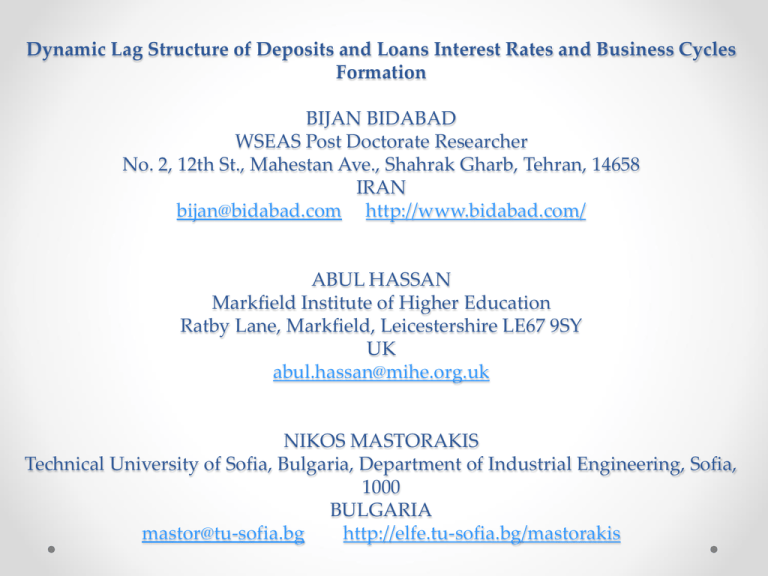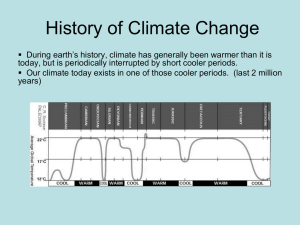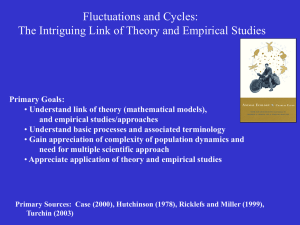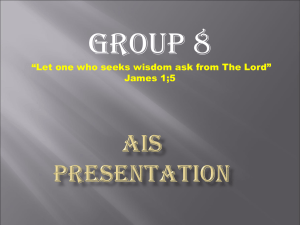Dynamic Lag Structure of Deposits and Loans Interest Rates and
advertisement

Dynamic Lag Structure of Deposits and Loans Interest Rates and Business Cycles Formation BIJAN BIDABAD WSEAS Post Doctorate Researcher No. 2, 12th St., Mahestan Ave., Shahrak Gharb, Tehran, 14658 IRAN bijan@bidabad.com http://www.bidabad.com/ ABUL HASSAN Markfield Institute of Higher Education Ratby Lane, Markfield, Leicestershire LE67 9SY UK abul.hassan@mihe.org.uk NIKOS MASTORAKIS Technical University of Sofia, Bulgaria, Department of Industrial Engineering, Sofia, 1000 BULGARIA mastor@tu-sofia.bg http://elfe.tu-sofia.bg/mastorakis Abstract • The purpose of the paper is to study the dynamic structure behavior of depositors, banks, and investors during business cycle by dichotomizing the money market into two markets of: saving-deposit and investment-credit. The empirical results show that in United States, the banking system creates fluctuations in money sector and real economy as well through interest rates. Short-term interest rates are the source of oscillation and this source of oscillation is emanated from interest rates’ effects to real sector, and form business cycles in the economy. The results also show that though the source of fluctuations in real economy comes from short term interest rates, however, medium and long terms interest rates dampens real economy fluctuations. Business Cycle Theories • This phenomenon was realized for the first time by Juglar (1862) for spans of 8-11 years. Later, several theories were introduced about business cycles, which studied business cycle from different points of view. • Schumpeter (1954) described the four stages of business cycle. The first stage of prosperity wherein there is an increase in production and prices and decrease of interest rate. During the second stage of recession wherein the production and prices decrease but interest rate increases until the third stage is reached of crisis due to collapse in stock market and bankruptcy. The recovery begins during the fourth stage, which is accompanied by stock exchange prosperity and the increase of output, demand and prices. Business Cycle Theories • • • • Goodwin (1949, 1991) believes that the reason for business cycles is the gap between income distribution between the profit of investors of economic firms and the earnings of labor force. When the economy has a high employment rate, the labor demand increases but the workers cannot ask for higher wages as the labor contracts are annual or have fixed periods and wages can only be changed after the end of the contract period. The reverse happens during recession. Therefore, the income of the labor force is adjusted with the income of capital factor after a time lag, which creates a cyclical behavior for matching production with consumption and ultimately shapes the cycle. Some economists believe that the reason for business cycles is technological shocks (Real Business Cycle Theory. Kydland and Prescott (1982)), The others believe that they are created by political parties and political decision cycles, (Political Business Cycle. Partisan Business Cycle, Michal Kalecki). Marxists believe it as the essence of capitalism, and neoclassic economists believe that the decrease of labor purchasing power is the reason for capitalistic crises. Business Cycle Theories • Samuelson (1939), fluctuation in total demand causes the economy to reach equilibrium in a short period, which is not in equilibrium at full employment. The motivation to obtain full employment in equilibrium and the inefficient excessive use of resources and factors of production and production capacity will lead to business cycles. • Keynesian theories believe that the lack of enough effective demand in the economy is an indigenous cause for crises while Classic and Neoclassic economists believe exogenous factors are the causes of business cycles. They believe supply will create its own demand (Say’s Law). • Samuelson’s (1939) Oscillator Model describes Keynesian analysis based on multiplier effect (on consumption) and accelerator (in investment) which create cycles through changes of total demand components. • The struggle between Keynesian and Classic economists can be introduced in this discussion. of Banks in Creation of Economic Cycles • • • • We hypothesize that crisis is a result of structural behavior in money and banking sector. The theory of credit cycles by Irving Fisher (1933) is one of the interesting theories about the cause of business cycles. He believed that credit cycles are the starting reason for economic cycles. In direction of Fisher theory, Minsky (1992) puts financial instability hypothesis forward and developed Fisher theory by describing credit bubbles and the burst of these bubbles and their effects on economic cycles. Recent researches such as Beaudry and Guay (1996) have also touched some aspects of the relation between interest rate and business cycle; but no one of them looks at the problem as is discussed in this paper. Beaudry, and Guay (1996) document the extent to which the predictions of standard Real Business Cycle (Kydland, and Prescott (1982)) models are incompatible with observed movements in real interest rates. of Banks in Creation of Economic Cycles • Blankenau et al (2001) express that while the world real interest rate is potentially an important mechanism for transmitting international shocks to small open economies, much of the recent studies show that this mechanism has little effect on output, investment, and net exports. • Ivanova et al (2000) have studied the comparative performance of a number of interest rate spreads as predictors of the German inflation and business cycle in the post-Bretton Woods era. Money Market and the Role of Banks in Creation of Economic Cycles Money Market and the Role of Banks in Creation of Economic Cycles • By generalizing this hypothesis we clearly see that whenever shocks occur in deposit supply or demand for banks' credit facilities (loan), because of time contracts, these shocks will be transferred to the other market in the next period and the fluctuations transfer from market to market alternatively and permanently fluctuates other related markets. • Interest rate in the deposit market is a function of interest rate in loan market in the last period. The adjustment takes place when the return movement occurs in the next period which means that the interest rate of loan market is itself a function of interest rate of deposit market in the previous period Transfer of Fluctuations from Money sector to Real sector • Equilibrium condition in macro economy will be: (inv–sav) + (gov–tax) + (ex-im–tr) • In other words, the equilibrium condition in the economy in time t will be as follows: • Or Transfer of Fluctuations from Money sector to Real sector If the government has balanced fiscal policy which means (govt taxt)=0 and the trade balance is also balanced (ext - imt - trt)=0, again the equilibrium (19) is a second order difference equation which can lead the economy into disequilibrium in different times. In other words, the mathematical behavior of equation (19) will be different regarding the behavioral characteristic of saving and loan contracts and the reaction of depositors and borrowers (investors) to interest rates of deposits and loans, which can show any kind of oscillatory behavior. Nevertheless, this behavior cannot be expanding (diverging) or dampening (converging) forever, because disequilibrium tends to zero in long run. Therefore, necessarily even if the equilibrium is a moving equilibrium, it should oscillate around its long run equilibrium and this phenomenon creates economic cycles. Capability of Second Order Difference Equations in Explaining Fluctuations Capability of Second Order Difference Equations in Explaining Fluctuations Empirical Investigations • To test the time structure of the interest rate the following interest rates were selected for a long period since 1948 till present: • Discount Rate (End of Period): • Federal Funds Rate: • Commercial Paper Rate: • Treasury Bill Rate: • Certificate of Deposit Rate: • Lending Rate: • Mortgage Rate: • Government Bond Yield: Long-Term and Short-Term: Different interest rates time trend. USA (%) for 1948-2009 Estimation results for ten estimated equations Dependent Variable Yt=ß0 + ß1.Yt-1 + ß2 .Yt-2 Sample obs. Yt ß0 ß1 ß2 R2 Certificates of Deposit Rate (secondary market-3 months) 1967-2009 43 CDR 1.412 1.173 -0.405 0.714 t-Stat. 2.124 7.828 -2.675 Commercial Paper Rate 1974-2009 36 CPR 1.092 1.208 -0.406 t-Stat. 1.609 7.807 -2.564 Discount Rate (End of Period) 1950-2009 60 DR 0.877 1.168 -0.349 t-Stat. 2.387 9.376 -2.786 Federal Funds Rate 1957-2009 53 FFR 1.159 1.121 -0.332 t-Stat. 2.241 8.255 -2.445 Lending Rate (Prime Rate) 1950-2009 60 LPR 1.193 1.195 -0.364 t-Stat. 2.553 9.559 -2.962 Treasury Bill Rate(Bond Equivalent-3 month ) 1977-2009 33 TBRBE 0.920 1.212 -0.384 t-Stat. 1.412 7.048 -2.153 Mortgage Rate 1974-2009 36 MR 0.713 1.301 -0.386 t-Stat. 1.140 7.983 -2.339 Treasury Bill Rate 1950-2009 60 TBR 0.738 1.173 -0.330 t-Stat. 2.126 9.257 -2.614 Govt. Bond Yield: Long Term (10 year) 1956-2009 54 GBYLT 0.511 1.103 -0.180 t-Stat. 1.491 7.973 -1.319 Govt. Bond Yield: Medium Term (3 year) 1950-2009 60 GBYMT 0.539 1.127 -0.222 t-Stat. 1.656 8.668 -1.718 0.761 0.774 0.721 0.799 0.768 0.874 0.792 0.880 0.856 Characteristic roots of the second order linear difference equations Variables yt+2=a.yt+1+b.yt+L a b L roots Real Imag. c d Characteristic roots D x', x" CDR Certificates of Deposit Rate (secondary market-3 month) -1.173 0.405 1.412 complex 0.586 0.865 1.045 0.586±0.865i CPR Commercial Paper Rate -1.208 0.406 1.092 complex 0.604 0.878 1.065 0.603±0.877i DR Discount Rate (End of Period) -1.168 0.349 0.877 complex 0.584 0.831 1.016 0.584±0.830i FFR Federal Funds Rate -1.121 0.332 1.159 complex 0.561 0.804 0.980 0.560±0.803i LPR Lending Rate (Prime Rate) -1.195 0.364 1.193 complex 0.598 0.849 1.039 0.597±0.849i TBRBE Treasury Bill Rate (Bond Equivalent3 month ) -1.212 0.384 0.920 complex 0.606 0.867 1.058 0.606±0.866i MR Mortgage Rate -1.301 0.386 0.713 real 0.843, 0.458 TBR Treasury Bill Rate -1.173 0.330 0.738 real 0.705, 0.469 GBYLT Govt. Bond Yield: Long Term (10 year) -1.103 0.180 0.511 real 0.903, 0.200 GBYMT Govt. Bond Yield: Medium Term (3 year) -1.127 0.222 0.539 real 0.872, 0.255 Conclusions • This paper examines the sources of business cycles. • We tried to find the initiator of business cycles, which is in fact the dynamic structure of different interest rates. • The study shows that there is important lag structure between deposit interest rates and loan interest rates. • The observed lag structure actually forms a second order difference equation behavior in banking sector as source of fluctuations, which starts from money sector and expands to real economy. • The estimated results show that short-term interest rates are the source of fluctuations. • The estimated dynamic equations for short-term interest rates had complex characteristic roots that let the equations be oscillatory. • The long-term and medium-term interest rates equations had real characteristic roots and were not oscillatory. Dynamic Lag Structure of Deposits and Loans Interest Rates and Business Cycles Formation BIJAN BIDABAD WSEAS Post Doctorate Researcher No. 2, 12th St., Mahestan Ave., Shahrak Gharb, Tehran, 14658 IRAN bijan@bidabad.com http://www.bidabad.com/ ABUL HASSAN Markfield Institute of Higher Education Ratby Lane, Markfield, Leicestershire LE67 9SY UK abul.hassan@mihe.org.uk NIKOS MASTORAKIS Technical University of Sofia, Bulgaria, Department of Industrial Engineering, Sofia, 1000 BULGARIA mastor@tu-sofia.bg http://elfe.tu-sofia.bg/mastorakis






